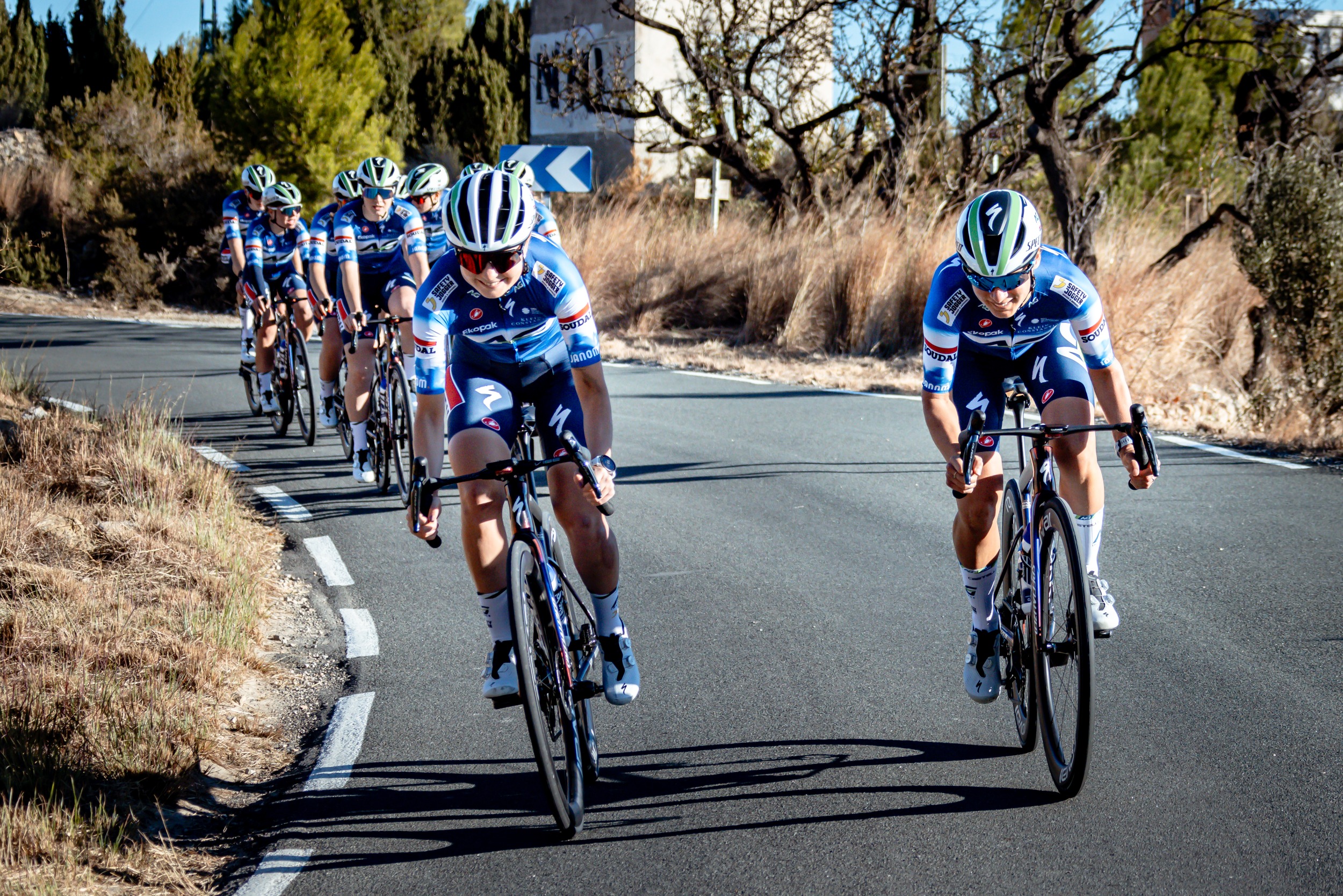

Article co-written by: Roxanne Takken
A Unique Physiology
Cycling is one of the most physically demanding sports, requiring high levels of endurance, strength, and mental resilience. While training methodologies have historically focused on male athletes, there is a growing recognition that female cyclists possess unique physiological characteristics. These distinctions influence training, performance, and recovery. By understanding these differences, coaches and athletes can develop more effective, individualized strategies that enhance performance while promoting long-term health.
Physiological male – female differences
Female cyclists exhibit distinct physiological differences in lung function, cardiac function, muscle mass, and blood parameters compared to their male counterparts. Generally, women have smaller lung volumes and lower maximal ventilatory capacity due to differences in thoracic size and airway diameter. This results in reduced peak expiratory flow rates and lower overall ventilatory efficiency during intense exercise. Despite this, trained female cyclists develop adaptations that improve ventilatory capacity, narrowing this gap in performance.
Cardiac function also shows sex-based differences. Women typically have smaller hearts and lower stroke volumes, which contribute to lower in values cardiac output. However, when adjusted for body dimensions, these differences diminish. Women often exhibit a higher heart rate at a given workload to compensate for their smaller stroke volume, maintaining cardiac output during high-intensity efforts.
Muscle mass differences are significant, with females having in general lower absolute muscle mass and higher body fat percentages. This affects power output and anaerobic capacity. Nevertheless, targeted strength and endurance training can significantly enhance muscular endurance and power in female cyclists.
Females typically have a higher percentage of Type I (slow-twitch) muscle fibers compared to males. This gives them an advantage in endurance events, as these fibers are more efficient at utilizing oxygen for sustained activity.
Blood parameters also influence oxygen transport capacity between sexes. Women generally have lower hemoglobin concentrations and hematocrit levels than men, reducing their blood’s oxygen-carrying capacity. This difference has an impact on aerobic capacity. However, trained female cyclists often show enhanced hemoglobin mass and red blood cell volume compared to untrained individuals, mitigating some of these differences. Additionally, females typically exhibit better capillary density and oxygen extraction efficiency at the muscular level, which helps optimize performance despite these challenges.
Regarding the VO2max (maxiumal oxygen uptake) in female cyclings there are only a few observations available. One of the highest observed VO2max values is from the Brazilian cyclist Flavia Oliveira, who reported a value of 76 ml/kg/min. Other studies have reported values of 55-60 ml/kg/min. Those values are lower compared to male counterparts. In general, females have a 255 lower VO2max compared to males.
In general, it is concluded that females are less fatigable during endurance activities compared to males.
Hormonal Influences on Performance
One of the most significant factors distinguishing female exercise physiology is the influence of hormones. Estrogen and progesterone, which fluctuate throughout the menstrual cycle, play a pivotal role in various physiological processes, including metabolism, thermoregulation, and neuromuscular control. Several commercial training packages like TrainingPeaks have now included a menstrual cycle tracker into its software.
Menstrual Cycle Phases and Training Adaptations:
Follicular Phase (Days 1-14):
Estrogen levels rise, peaking just before ovulation. During this phase, women may experience increased strength and endurance. Training intensity can be optimized here, focusing on strength and high-intensity interval training (HIIT).
– Luteal Phase (Days 15-28):
Progesterone dominates, and the body temperature increases. Endurance performance may decrease slightly due to changes in thermoregulation and increased perceived exertion. Aerobic sessions and recovery-focused training are more appropriate during this phase.
Research suggests that aligning training programs with menstrual cycle phases can enhance performance and reduce the risk of overtraining or injury. However, individual variations mean that female cyclists must closely monitor their responses to training stimuli.
Strength and Neuromuscular Training for Cyclists:
Incorporating strength training can bridge the power gap. Resistance training focusing on compound movements (like squats, deadlifts, and lunges) enhances neuromuscular efficiency, which translates to better power output on the bike. Core stability is also essential for maintaining posture and reducing energy wastage during long rides. Women often show a slower rate of force development (RFD) compared to men. This can be improved through plyometric exercises and high-intensity sprints, which enhance explosive power and overall cycling performance. Furthermore, we see a lower increase in muscle mass after strength training in females compared to males. This implies that enhancing strength through better neuromuscular control plays an important role for females to become stronger. Strength exercises using lower weights and more repetitions will help to increase the neuromuscular control.
Metabolic Considerations and Fuel Utilization
Metabolism in female cyclists differs from that of males, particularly in fuel utilization during exercise. Women are generally more efficient at oxidizing fats, especially during prolonged, moderate-intensity efforts. This metabolic advantage allows them to conserve glycogen stores, which is crucial for endurance performance. This fact is often mentioned in relation to endurance performance.
Implications for Nutrition:
Given their enhanced fat utilization, female cyclists may benefit from slightly different nutritional strategies than men. Please be aware that many of the recommendations are based on male research, taking into account a healthy young male subject with a body mass of 70 kg.
Key considerations include:
Bone Health and Injury Prevention
Bone health is a critical consideration for female cyclists. The combination of low body weight, high training volume, and hormonal fluctuations can increase the risk of bone density loss and stress fractures, particularly in athletes with low energy availability (LEA) or those experiencing the female athlete triad (disordered eating, absence of a menstrual period, and osteoporosis) or Relative Energy Deficiency in Sport (RED-s).
Strategies for Maintaining Bone Health:
– Nutrition: Ensure adequate intake of calcium, vitamin D, and phosphorus.
– Strength Training: Incorporating weight-bearing exercises such as running can strengthen bones and reduce injury risk.
– Monitoring Menstrual Health: Irregular or absent menstrual cycles can indicate underlying issues that need to be addressed to protect long-term health.
Training Strategies Tailored for Female Cyclists
To optimize performance, training programs should be tailored to the unique physiological needs of female cyclists. Key principles include:
Implement a periodized training plan that aligns with the menstrual cycle. High-intensity and strength sessions can be scheduled during the follicular phase, while the luteal phase can focus on endurance and active recovery.
Regular strength training sessions, particularly in the off-season, can enhance power output and reduce the risk of injury. Exercises should target both lower and upper body muscles, with a strong emphasis on core stability.
Long, steady-state rides help develop the aerobic capacity that female cyclists excel in. Integrating interval training enhances VO2 max and improves lactate threshold, critical for competitive success.
Considerations for Junior Female Cyclists
Junior female cyclists face unique physiological and developmental challenges as they grow into elite athletes. Their training must balance performance enhancement with the need for healthy growth and development. During adolescence, rapid hormonal changes can impact energy levels, recovery, and muscle development.
Also, there are rapid changes in height, weight and body composition during the growth spurt. This spurt occurs on average 1.5 years earlier than in boys, giving them an advantage over boys during this period when they are taller and stronger.
Emphasizing foundational skills, endurance building, and strength training is crucial while avoiding excessive training loads that could lead to overtraining or injury especially during the growth spurt. Additionally, promoting proper nutrition and menstrual health awareness ensures young female cyclists build a strong, sustainable foundation for future success.
Conclusion: Toward More Inclusive Research and Training
The field of exercise physiology has made significant strides in understanding the unique needs of female athletes, but there is still much to learn. Historically, sports science research has been male-dominated, leading to generalized recommendations that may not apply to females. As more studies focus on female physiology, training and nutrition strategies will become increasingly personalized and effective.
By embracing these insights, female cyclists can optimize their training, reduce injury risks, and unlock their full potential. The future of cycling lies in recognizing and addressing these differences, paving the way for more inclusive and empowering practices in the sport.